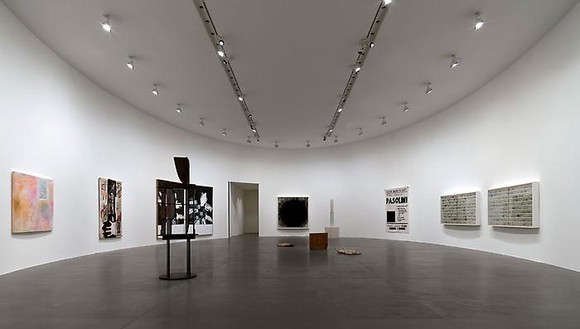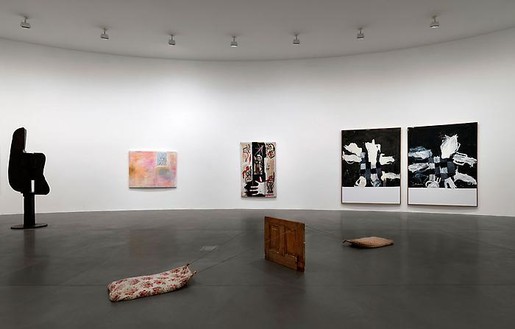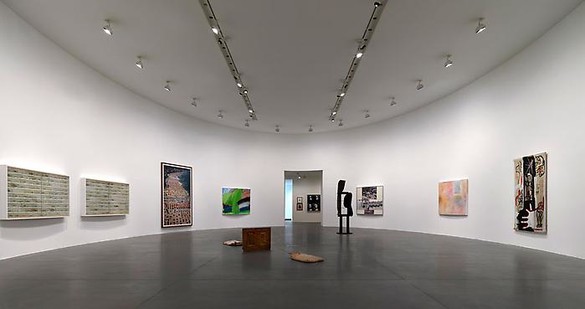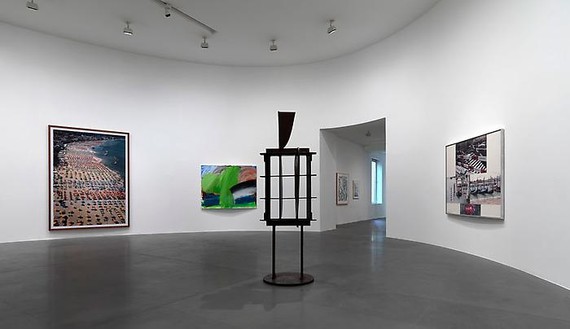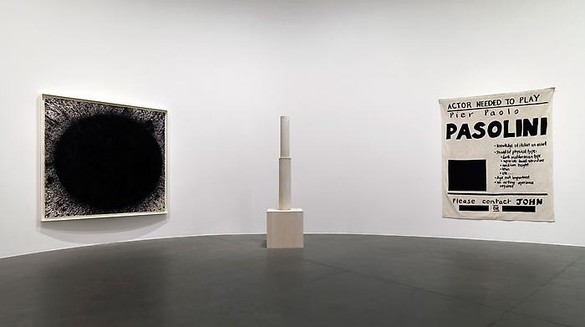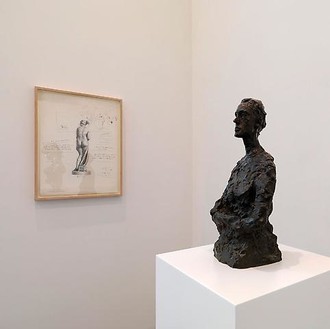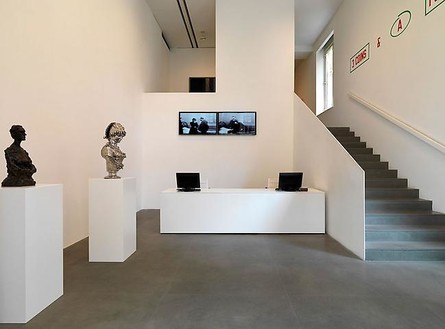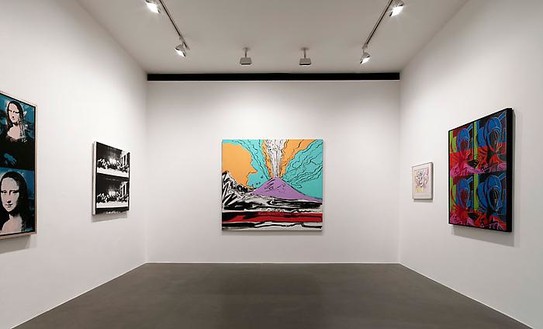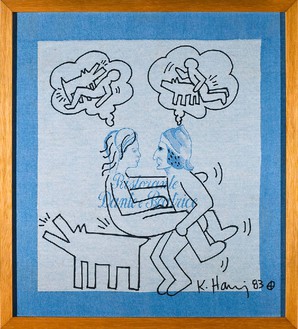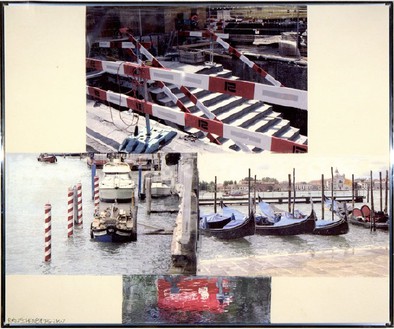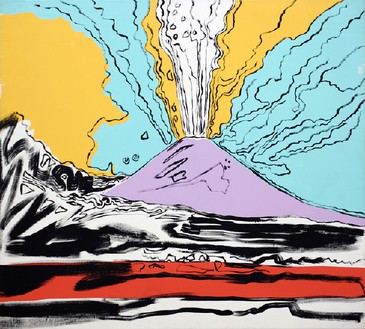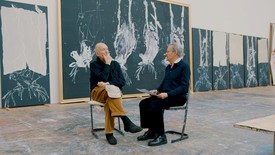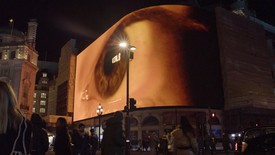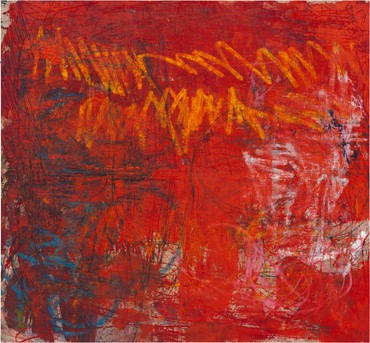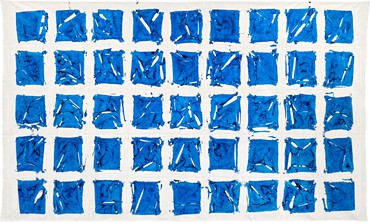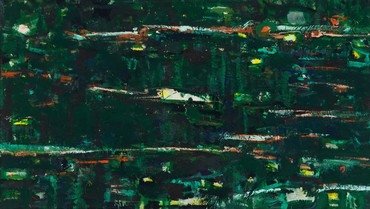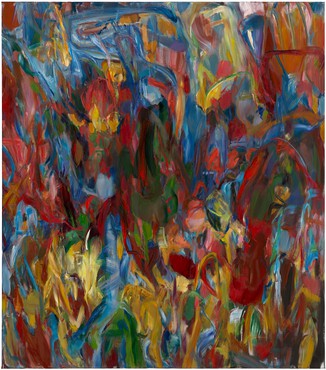About
Say what ill of it you may; [Italy] still remains to the poet the land of his predilection, to the artist the land of his necessity, and to all the land of dreams and visions of delight.
—Henry W. Longfellow (1807–1882)
Gagosian Rome is pleased to present Made in Italy, a group show marking the 150th anniversary of Italy’s unification.
The exhibition maps an unexpected Italian journey through works by seminal artists of the past sixty years: Georg Baselitz, Jean-Michel Basquiat, Joseph Beuys, Dike Blair, Marcel Duchamp, Alberto Giacometti, Douglas Gordon, Andreas Gursky, Keith Haring, Damien Hirst, Howard Hodgkin, Mike Kelley, Jeff Koons, Louise Lawler, Roy Lichtenstein, Richard Prince, Robert Rauschenberg, Gerhard Richter, Richard Serra, Cindy Sherman, David Smith, Thomas Struth, Cy Twombly, Andy Warhol, and Lawrence Weiner.
Italy’s irresistible appeal to international artists is deeply rooted in history. In the tradition of the Grand Tour popular during the eighteenth and nineteenth centuries, British, American, French, and German travelers crossed the Alps to witness what they had previously only experienced in books: the wonders of the classical tradition, the masterpieces of an idealized past, as well as the thrill that the distinct Italian lifestyle and customs kindled. Immersing themselves in the marvels of the past and the harmonious disarray of the present, artists from near and far negotiated the trials and tribulations of early tourism. From Venice’s Byzantine exoticism, the cerebral sensuality of the Florentine Renaissance, and the beguiling vestiges of classical Rome, Italy became an inspiring artistic idea and ideal. This infatuation continued into the twentieth century, during which tourism became easier and accessible to many. Experiencing the animated cities or pastoral idylls of Italy remains a rite of passage in the careers of many contemporary artists.
Si parli pur male di essa; [l’Italia] rimane per il poeta il luogo prediletto, per l’artista il luogo necessario, e per tutti il luogo di sogni e incantevoli visioni.
—Henry W. Longfellow (1807–1882)
In occasione dei 150 anni dall’Unità d’Italia, Gagosian é lieta di annunciare Made in Italy, un’importante mostra collettiva nel suo spazio romano di Via Francesco Crispi 16.
Curata da Mario Codognato, la mostra intende tracciare un inedito percorso italiano attraverso l’opera di alcuni tra i maggiori artisti degli ultimi 60 anni: Georg Baselitz, Jea n Michel Basquiat, Joseph Beuys, Dike Blair, Marcel Duchamp, Alberto Giacometti, Douglas Gordon, Andreas Gursky, Keith Haring, Damien Hirst, Howard Hodgkin, Mike Kelley, Jeff Koons, Louise Lawler, Roy Lichtenstein, Richard Prince, Robert Rauschenberg, Gerhard Richter, Richard Serra, Cindy Sherman, David Smith, Thomas Struth, Cy Twombly, Andy Warhol, Lawrence Weiner.
L’irresistibile attrazione esercitata dal “Bel Paese” nei confronti degli artisti del resto del mondo affonda le radici nel passato profondo e, com’é noto, conosce il momento di splendore a cavallo tra Settecento e Ottocento, all’epoca del cosiddetto Grand Tour, quando artisti-viaggiatori inglesi, americani, francesi e tedeschi varcano le Alpi per sperimentare da vicino la grande tradizione classica conosciuta solo sui libri, i capolavori di un passato idealizzato, ma anche il brivido provocato da uno stile di vita diverso e alternativo rispetto a quello che conoscono in patria. É così che, sfidando le difficoltà di un turismo tutt’altro che confortevole, artisti da ogni dove s’immergono nelle meraviglie del passato e nel vitalistico disordine del presente. L’Italia diventa idea e ideale artistico: gli esotismi bizantini di Venezia, la sensualità del Rinascimento fiorentino, l’infatuazione per le vestigia della Roma classica, stordiscono e ispirano. E la liaison non s’interrompe neppure durante il XX secolo, allorché viaggiare diventa più facile, meno “straordinario” e alla portata di molti. L’esperienza italiana, la residenza nelle nostre turbolente città o l’immersione nelle pastoralità delle nostre campagne, rimane il passaggio eccezionale nella carriera di tanti artisti di primo piano, il momento d’oro della loro visione, la felice congiunzione della bellezza del passato con il presente creativo che ognuno di loro rappresenta.
É sorprendente notare infatti come a più di 300 anni dall’inizio di questa tradizione, l’esperienza italiana rimanga ancora così rilevante da emergere ancora, a volte anche ripetutamente, nella produzione di numerosi artisti moderni e contemporanei. Ed ancora più sorprendente é scoprire che per la contemporaneità non é solo l’impareggiabile ricchezza storico-artistica ma spesso anche la caleidoscopica molteplicità del vivere italiano a rappresentare una suggestione imperdibile.
Così, solo per fare alcuni esempi presenti in mostra, sono i capolavori della storia dell’arte di tutti i tempi, da Leonardo, De Chirico a Caravaggio per Warhol, Duchamp e Sherman; l’archeologia per Lichtenstein o Basquiat; ma anche l’universalità del paesaggio per Richter e Gursky; l’unicità del canone femminile per Giacometti e Koons; la storia o i personaggi della cultura contemporanea per Beuys, Kelley e Serra a costituire un terreno di indagine privilegiato ed inaspettatamente condiviso da grandi artisti così eterogenei tra loro.
“L’Italia, o meglio le tante civiltà che si sono succedute nei millenni nelle città e nei territori di quella che da 150 anni chiamiamo Italia, costituiscono un caso unico di continuità storica e artistica”, spiega il curatore della mostra Mario Codognato. “Questa peculiarità l’ha resa un punto di riferimento, di attrazione e di scontro per gli artisti visivi di tutto il mondo occidentale. L’Italia ha una doppia identità, è passato e presente, è archeologia e creatività contemporanea, coagula simultaneamente il peso della tradizione e le contraddizioni della modernità.”
Made in Italy ambisce a ricostruire attraverso una serie di opere di alcuni grandi protagonisti dell’arte moderna e contemporanea il percorso personale e creativo che li ha portati, in un momento specifico della loro carriera, a confrontarsi con quel patrimonio universale che si chiama Italia.
Share

Now available
Gagosian Quarterly Spring 2024
The Spring 2024 issue of Gagosian Quarterly is now available with a fresh cover design featuring Jean-Michel Basquiat’s Lead Plate with Hole (1984).
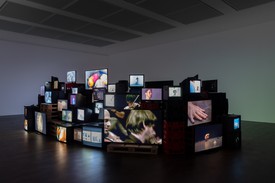
Douglas Gordon: To Sing
On the occasion of Douglas Gordon: All I need is a little bit of everything, an exhibition in London, curator Adam Szymczyk recounts his experiences with Gordon’s work across nearly three decades, noting the continuities and evolutions.
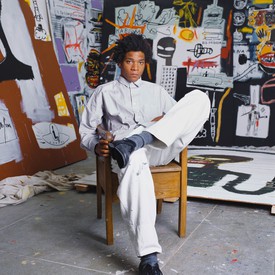
Jean-Michel Basquiat: Los Angeles
Jean-Michel Basquiat’s sisters, Lisane Basquiat and Jeanine Heriveaux, met with filmmaker Tamra Davis, art dealer Larry Gagosian, and author and curator Fred Hoffman to reflect on their experiences with the artist during the 1980s in Los Angeles.
In Conversation
Georg Baselitz and Richard Calvocoressi
In conjunction with the exhibition The Painter in His Bed, at Gagosian, New York, Georg Baselitz and Richard Calvocoressi discuss the motif of the stag in the artist’s newest paintings.
In Conversation
Irving Blum and Dorothy Lichtenstein
In celebration of the centenary of Roy Lichtenstein’s birth, Irving Blum and Dorothy Lichtenstein sat down to discuss the artist’s life and legacy, and the exhibition Lichtenstein Remembered curated by Blum at Gagosian, New York.
Douglas Gordon: if when why what
Douglas Gordon took over the Piccadilly Lights advertising screen in London’s Piccadilly Circus, as well as a global network of screens in cities including Berlin, Melbourne, Milan, New York, and Seoul, nightly for three minutes at 20:22 (8:22pm) throughout December 2022, with his new film, if when why what (2018–22). The project was presented by the Cultural Institute of Radical Contemporary Art (CIRCA) in conjunction with the exhibition Douglas Gordon: Neon Ark at Gagosian, Davies Street, London.
